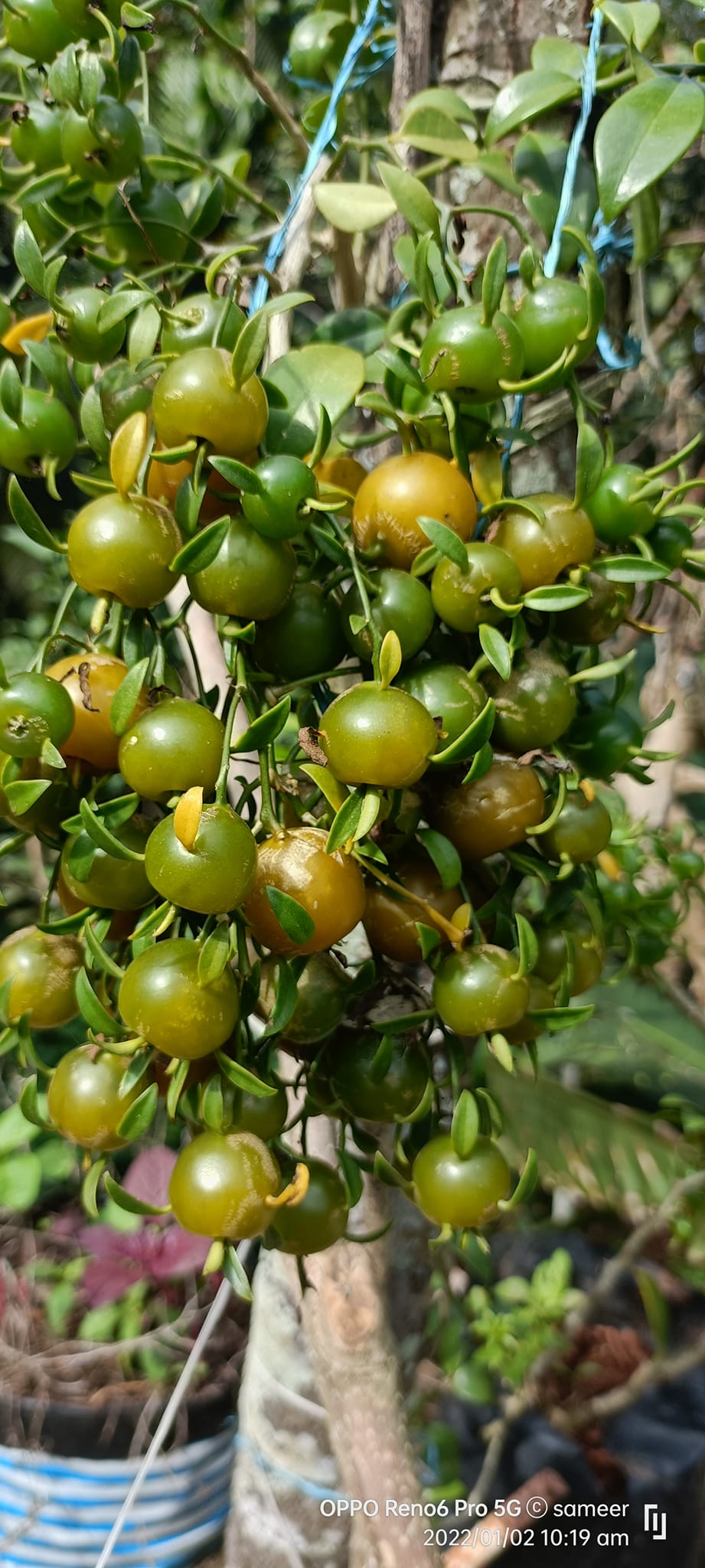Love it? Add to your wishlist
Your favorites, all in one place. Shop quickly and easily with the wishlist feature!
[message]
[title]
[message]



Veliyath Gardens
Couldn't load pickup availability
Lemon Vine (Pereskia aculeata): The Thorny Wonder with Edible Leaves and Vitamin-Rich Fruits
Among the lesser-known but power-packed climbers of the tropical world, the Lemon Vine, botanically named Pereskia aculeata, stands out as an exceptional blend of nutrition, resilience, and culinary versatility. Widely admired across Brazil, the Caribbean, and even parts of Southeast Asia, this unique plant—also called Barbados Gooseberry, Leaf Cactus, Rose Cactus, and Blade-Apple Cactus—has intrigued gardeners and health seekers alike with its unusual features.
Botanical Name: Pereskia aculeata
Common Names: Lemon Vine, Barbados Gooseberry, Leaf Cactus, Blade-Apple Cactus, Rose Cactus
Native Regions: Tropical America, particularly Brazil and the West Indies
Presence Around the World: Widely grown in South America, introduced into India, Indonesia, and tropical Africa for both ornamental and culinary uses
The fruit of Lemon Vine is a small, globe-shaped berry, golden yellow to deep orange when ripe, with a translucent and juicy pulp. A closer look reveals the fruit's smooth, delicate skin and tiny thorns on the outer layer—typical of a cactus relative. Inside, the flesh is pleasantly tangy with hints of citrus and sweetness, offering a refreshing snack for tropical fruit lovers.
What makes Pereskia aculeata even more interesting is its fleshy, edible leaves, packed with plant-based protein and minerals. Unlike most other cacti, it grows broad, meaty leaves that are both nourishing and palatable.
Leaves Nutritional Profile (Dry Weight):
Protein Content: Up to 30%—higher than many conventional leafy greens
Iron: Supports healthy red blood cells
Calcium & Phosphorus: Builds stronger bones
Magnesium: Crucial for muscle function and cellular repair
Fruit Nutritional Value:
Vitamin C: Known for immunity-boosting and skin-renewing properties
Hydrating Properties: High water content makes it a great fruit for tropical summers
Antioxidants: Helps the body combat oxidative stress and premature aging
Boosts Immunity: Rich in Vitamin C and antioxidants that fight infections and build resilience
Hydrates Naturally: The juicy fruit helps retain body fluids during hot seasons
Supports Weight Management: Low in calories and high in fiber, this fruit and its leaves promote satiety
Improves Bone Strength: With its calcium and magnesium content, it contributes to skeletal health
Detoxifies the Body: Natural diuretic effect that aids digestion and detox
The taste of Lemon Vine fruit is delicately tart-sweet, similar to gooseberry but with its own exotic identity. Its refreshing, citrus-like acidity makes it ideal for eating raw or as a flavor enhancer in salads, smoothies, or traditional dishes. The leaves, slightly mucilaginous like Malabar spinach, are cooked or sautéed with spices and used in soups or stir-fries.
Eaten Fresh: A handful of ripe fruits can be consumed as-is, after removing seeds and any surface thorns
Juices and Coolers: The fruit’s sharp tang lends itself well to energizing summer drinks
Chutneys and Sauces: Often used in tangy side preparations in Brazil
Leaf-Based Dishes: Leaves are cooked in curries or added to lentil soups for a protein-rich boost
Preserved: Fruits are made into jams and jellies, especially in traditional households
Growth Type: This is a fast-growing, thorny vine that climbs on support structures and can cover large trellises or fences.
Canopy and Habit: Dense foliage with large edible leaves and vibrant yellow-orange berries
Climate Needs: Tropical to sub-tropical regions with warm temperatures and high humidity
Soil Preference: Well-draining loamy or sandy soils enriched with compost
Sunlight: Thrives in full sunlight; partial shade is tolerated but may affect fruiting
Bloom and Fruiting: Begins producing fruits typically within 3–4 years
Watering: Moderate watering, especially during the dry season; avoid waterlogging
Fertilization: Use compost or organic manure twice yearly for better yield
Pruning: Trim long branches to encourage bushier growth and better flowering
Pest Control: Generally pest-resistant but watch for leaf-eating insects—organic neem spray works well
Propagation: Through stem cuttings or seeds, though cuttings give faster results
Storage: Ripe fruits can be refrigerated for up to 5–7 days
Freezing: Pulp can be extracted and frozen for later use in drinks and desserts
Pickling and Jams: Fruits are commonly preserved in sugar syrup or vinegar for seasonal use
Leaf Storage: Fresh leaves can be wrapped in damp cloth and refrigerated for 2–3 days
In several South American communities, the Lemon Vine plant is grown both as a nutritive food source and as a protective hedge due to its thorny nature. Some cultures also use the leaves in herbal teas and decoctions, believing it purifies the body and helps reduce inflammation. In parts of Brazil, it is fondly referred to as a “survival plant,” valued during droughts and times of scarcity.
Whether you're a nutrition-conscious gardener, a culinary explorer, or someone who values traditional wisdom, the Lemon Vine offers multiple reasons to grow it:
Nutrient Powerhouse: Both fruits and leaves are loaded with health-giving nutrients
Unique Culinary Addition: Introduces a new flavor to salads, drinks, and regional dishes
Garden Beauty with a Purpose: A thorny climber that doubles as a living fence or natural shade
Low Maintenance: Grows well in tropical environments with modest care
Medicinal Potential: Used in folk medicine and herbal diets for centuries
The Lemon Vine (Pereskia aculeata) is not your typical fruit plant. With its high-protein leaves, vitamin-rich fruits, and eco-friendly growth, it adds more than just green to your garden—it adds value, taste, and tradition. Introduce this rare gem from tropical America to your backyard and enjoy the fusion of nourishment and novelty.
Make it a part of your home with a Lemon Vine plant from Veliyath Gardens—because every garden deserves a fruit that feeds both the body and the spirit.
Watering: Moderate watering, especially during the dry season; avoid waterlogging
Fertilization: Use compost or organic manure twice yearly for better yield
Pruning: Trim long branches to encourage bushier growth and better flowering
Nutrient Powerhouse: Both fruits and leaves are loaded with health-giving nutrients
Unique Culinary Addition: Introduces a new flavor to salads, drinks, and regional dishes
Garden Beauty with a Purpose: A thorny climber that doubles as a living fence or natural shade
Low Maintenance: Grows well in tropical environments with modest care
The Lemon Vine (Pereskia aculeata) is not your typical fruit plant. With its high-protein leaves, vitamin-rich fruits, and eco-friendly growth, it adds more than just green to your garden—it adds value, taste, and tradition.




